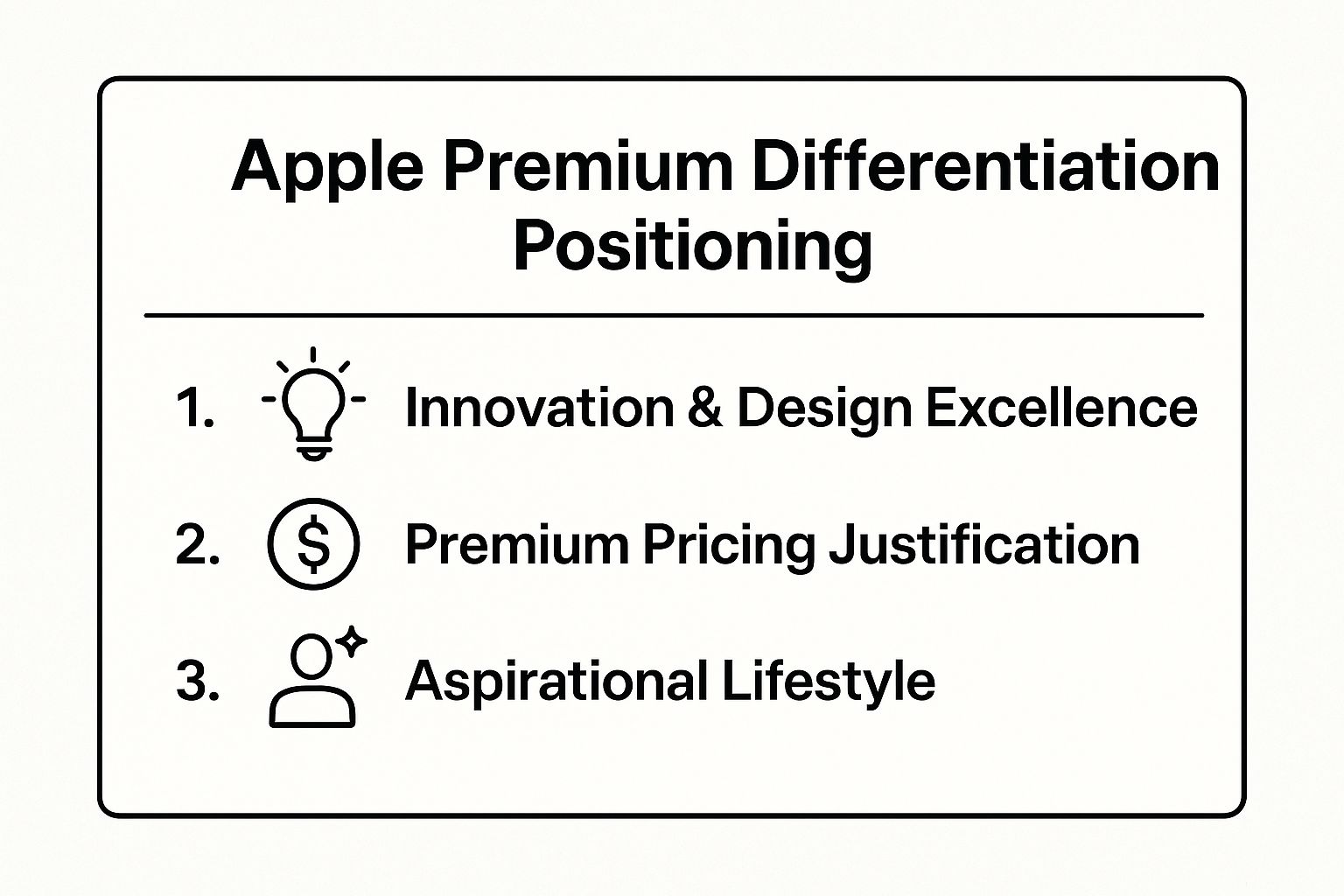Henri Den: Why Brand Positioning Statements Matter
Hey there, it's Henri Den. After 27 years of experience, I know a powerful brand positioning statement is your compass to clarity. This listicle provides brand positioning statement examples from iconic brands like Apple, Nike, and Tesla to inspire your own. Learn how these companies use positioning to achieve market dominance and discover how crafting your own statement can define your unique value, attract your ideal clients, and fuel sustainable growth. Ready to get inspired? Let's dive into these brand positioning statement examples.
1. Apple's Premium Differentiation Positioning
Apple's brand positioning is a masterclass in premium differentiation. It's a strategic approach that elevates the brand above competitors by emphasizing superior quality, innovative design, and a seamless user experience. Instead of competing on price, Apple focuses on delivering exceptional value and cultivating a sense of aspiration. This resonates deeply with customers willing to pay a premium for products that enhance their lives and reflect their values. This approach, meticulously crafted over decades, has propelled Apple to become one of the world’s most valuable brands. This method isn't just about charging more; it's about offering more – more innovation, more beauty, more integration, and ultimately, more value as perceived by the customer.

The infographic above summarizes Apple's key differentiators: innovation, design, and user experience. These pillars work together to create a premium brand perception, justifying higher prices and fostering strong customer loyalty. For anyone looking for brand positioning statement examples, Apple’s strategy provides a powerful blueprint.
This method works by creating a distinct space for the brand in the market. By focusing on specific features and benefits – in Apple's case, innovation, design, and seamless integration – they carve out a niche that caters to a specific audience willing to invest in quality and experience. This allows Apple to command premium prices and cultivate unwavering brand loyalty. Their informal positioning statement exemplifies this: "For individuals who want the best personal technology products in the world, Apple offers beautifully designed, innovative products that make people's lives better." Another powerful example is their iconic "Think Different" campaign, which positioned Apple as the brand for creative innovators.
Key Takeaways:
- Focus: Innovation, Design, User Experience
- Target Audience: Individuals seeking the best technology
- Benefit: Enhanced lifestyle through premium products
- Result: Strong brand loyalty and premium pricing power
These key takeaways highlight the core components of Apple's success. Let's explore the pros and cons of this approach.
Pros:
- Justifies premium pricing
- Creates strong brand loyalty
- Establishes clear market differentiation
- Allows for consistent messaging across product lines
Cons:
- Limits market reach to those willing to pay premium prices
- Creates high consumer expectations that must be consistently met
- Requires continuous innovation to maintain positioning
Tips for Implementing Premium Differentiation:
- Ensure quality: Your premium positioning must be backed by actual product quality. Don't over-promise and under-deliver.
- Consistent messaging: Maintain a consistent brand message across all customer touchpoints.
- Emotional benefits: Focus on the emotional benefits your product/service provides alongside the functional ones. How does it make your customer feel?
- Invest in design and UX: Prioritize design and user experience. These are critical components of a premium brand.
This approach is particularly relevant for:
- Solopreneurs: Differentiate your service business in a crowded market.
- Aspiring Creators: Establish a unique position and attract a loyal following.
- Career Pivoters: Craft a premium personal brand that commands attention.
- Coaches/Consultants: Attract high-value clients willing to invest in your expertise.
- Purpose-Driven Professionals: Align your work with your values and attract clients who share them.
Apple's success demonstrates the power of premium differentiation. While it requires significant investment and continuous innovation, the rewards – strong brand loyalty, premium pricing, and a clearly defined market position – are substantial. Learn more about Apple's Premium Differentiation Positioning and consider how you can adapt these principles to elevate your own brand.
2. Volvo's Safety-First Positioning
Volvo stands as a shining example of the power of single-minded brand positioning. For decades, they've meticulously cultivated an image synonymous with safety, transforming this core attribute into a potent differentiator in the fiercely competitive automotive market. This unwavering focus has not only resonated deeply with safety-conscious consumers but has also guided their product development and innovation. It’s a powerful example of how a brand positioning statement can shape an entire company’s trajectory.

This approach centers around owning a single, dominant characteristic that defines the brand in the minds of consumers. For Volvo, that's safety. This isn't just a marketing slogan; it's woven into the fabric of their company culture, influencing everything from engineering and design to advertising and customer service. This dedication is evidenced by their pioneering invention of the three-point seatbelt and the remarkable decision to share the patent freely, prioritizing global safety over potential profits. This single act solidified their commitment to safety in the public consciousness. Further reinforcing this commitment was their ambitious vision – “that no one will be seriously injured or killed in a new Volvo by 2020.” While not fully achieved, this aspirational goal clearly communicated their unwavering dedication to safety. This powerful brand positioning statement example demonstrates how focusing on a single attribute can create a lasting impact.
Volvo’s success provides invaluable lessons for solopreneurs, aspiring creators, career pivoters, coaches, consultants, and purpose-driven professionals alike. By focusing on a key attribute that resonates with your target audience, you can carve out a unique space for yourself in a crowded market. Volvo’s example showcases the effectiveness of this strategy for various brand positioning statement examples.
Features of Volvo's Safety-First Positioning:
- Single-attribute focus on safety: All messaging and product development revolves around this core value.
- Consistent messaging over decades: This long-term consistency has built immense brand equity.
- Backed by product innovation and features: Volvo continuously invests in safety technology, substantiating their claims.
- Balance of emotional (family safety) and functional (safety features) benefits: This appeals to both the heart and the mind of consumers.
Pros:
- Creates a clear, memorable brand association: Consumers instantly associate Volvo with safety.
- Appeals to a specific customer segment (safety-conscious consumers): This targeted approach fosters strong brand loyalty.
- Difficult for competitors to challenge: Volvo’s long-standing commitment to safety has created a formidable barrier to entry.
- Provides clear direction for product development: The focus on safety guides innovation and feature development.
Cons:
- May limit appeal to consumers seeking other primary benefits (e.g., performance, luxury): Overemphasis on safety might alienate consumers prioritizing other attributes.
- Challenging to expand brand meaning beyond safety: Breaking free from the "safety" mold can be difficult.
- Requires continuous innovation in safety technology: Maintaining leadership in safety demands ongoing investment and development.
Tips for Applying Volvo’s Strategy:
- Identify a single, powerful attribute that can define your brand. What unique value do you offer?
- Ensure the attribute is relevant to your target audience. Does it address their needs and desires?
- Back your positioning with actual product features and innovations. Don’t just talk the talk; walk the walk.
- Be consistent with your positioning across all platforms and over time. Consistency builds trust and reinforces your message.
Volvo’s positioning offers a powerful blueprint for building a strong brand. By focusing on a core attribute and consistently delivering on its promise, you can create a distinct identity that resonates with your target audience and sets you apart from the competition. Learn more about Volvo's Safety-First Positioning and other inspiring brand values examples to fuel your own branding journey. Consider how this method might apply to your own brand positioning statement examples and how it can inspire you to create a truly impactful brand.
3. Nike's Empowerment Positioning
Nike's brand positioning isn't just about selling shoes or sportswear; it's about selling a feeling, an aspiration. It's about tapping into the inherent human desire to push limits, achieve greatness, and become the best version of oneself. This emotionally-driven positioning, centered around athletic empowerment and achievement, inspires and enables athletes of all levels – from weekend warriors to Olympic champions – to reach their full potential. Nike doesn't just offer products; it offers a pathway to self-improvement, fueled by determination, hard work, and the right gear. This approach is a prime brand positioning statement example for businesses looking to connect with their audience on a deeper level.

Nike's success lies in its ability to transcend product features and create a movement. Their positioning statement, "For athletes in pursuit of their potential, Nike gives confidence that they are equipped with the best products, services, and inspiration," perfectly encapsulates this philosophy. This resonates with a broad demographic, appealing to both seasoned athletes and those just starting their fitness journey. The iconic "Just Do It" tagline further reinforces this powerful message, urging individuals to overcome obstacles and embrace the challenge. Athlete endorsements, featuring icons like Michael Jordan, deepen the brand's connection to achievement and inspire millions worldwide. Learn more about Nike's Empowerment Positioning and see how powerful storytelling reinforces this positioning.
Features of Nike's Empowerment Positioning:
- Emotionally-driven: Focuses on feelings of achievement, motivation, and self-improvement.
- Universal appeal: Resonates with athletes of all skill levels and backgrounds.
- Aspirational messaging: Emphasizes potential and encourages pushing boundaries.
- Movement-driven: Creates a community of like-minded individuals striving for greatness.
Pros:
- Deep emotional connection: Fosters loyalty and brand advocacy.
- Brand extension: Enables expansion into new product categories and markets.
- Broad demographic appeal: Attracts a diverse customer base.
- Clear marketing direction: Provides a consistent foundation for campaigns.
Cons:
- Constant reinforcement: Requires ongoing investment in inspirational marketing.
- High expectations: Product performance must live up to the brand's promise.
- Competitive landscape: Faces challenges from other brands adopting similar emotional positioning.
Tips for Implementing Empowerment Positioning:
- Focus on emotional benefits: Identify the core desires and aspirations of your target audience. For solopreneurs, this could be independence and financial freedom. For career pivoters, it might be finding purpose and fulfillment.
- Simplicity and power: Express your positioning in concise, memorable terms. Think "Just Do It" – short, impactful, and universally understood.
- Storytelling: Share inspiring stories of transformation and achievement that resonate with your audience. Aspiring creators can leverage this to build a loyal following.
- Cultural connection: Align your positioning with relevant cultural movements and values. This is particularly important for purpose-driven professionals seeking to make a positive impact.
Nike's empowerment positioning provides a powerful brand positioning statement example, demonstrating how a brand can connect with consumers on a deep emotional level and inspire them to pursue their dreams. Whether you're a solopreneur building a service business, an aspiring creator finding your voice, or a career pivoter seeking direction, Nike's approach offers valuable lessons in building a brand that resonates and inspires. By focusing on empowerment, aspiration, and the pursuit of potential, you can create a brand that not only sells products or services but also empowers individuals to become their best selves.
4. Whole Foods' Conscious Consumption Positioning
Whole Foods Market provides a powerful brand positioning statement example, demonstrating how a company can build a brand around deeply held values. Their conscious consumption positioning resonates with a growing segment of shoppers who prioritize health, ethical sourcing, and environmental responsibility. This approach not only differentiates them from conventional supermarkets but also justifies their premium pricing structure. This makes Whole Foods a particularly relevant brand positioning statement example for purpose-driven professionals and aspiring creators seeking to align their work with a stronger mission.
How it Works:
Whole Foods connects with consumers on an emotional level by appealing to their values. They've built a community around shared beliefs about food and its impact on the world. This strategy goes beyond simply selling groceries; it promotes a lifestyle. This focus on conscious consumerism is a powerful differentiator, especially in a crowded market. By emphasizing what they sell and *what they don't sell (artificial preservatives, for example), Whole Foods establishes trust and transparency, key ingredients for any successful brand positioning statement.
Examples of Successful Implementation:
- Positioning Statement: "For people who are passionate about food and the planet, Whole Foods Market is the grocery store that offers the highest quality natural and organic foods, setting the standards of excellence for food retailers." This statement clearly identifies their target audience and core value proposition.
- Quality Standards Messaging: Whole Foods transparently communicates their quality standards by highlighting what they won't sell, building trust and reinforcing their commitment to natural and organic products.
- Local Supplier Programs: Supporting local farmers and producers strengthens their community focus and resonates with consumers who value local sourcing.
Tips for Implementing Conscious Consumption Positioning:
- Authenticity is Key: Ensure your values-based positioning aligns with your actual business practices. If you claim to be sustainable, you must back it up with demonstrable actions. This is critical for solopreneurs building service businesses and career pivoters establishing a new brand identity.
- Transparency Builds Trust: Make your standards visible and easily accessible to consumers. Be upfront about your sourcing, production, and business practices.
- Educate Your Audience: Help consumers understand the benefits of your approach. Explain why your sourcing matters, why organic is better, or how your service contributes to a greater good. This is especially valuable for coaches and consultants positioning themselves as experts.
- Community Building: Create opportunities for like-minded individuals to connect around shared values. This could involve workshops, online forums, or local events.
Pros:
- Appeals to the growing segment of conscious consumers.
- Justifies premium pricing.
- Fosters a community of like-minded individuals.
- Differentiates from competitors.
Cons:
- Limited appeal to price-sensitive consumers (the "Whole Paycheck" nickname).
- Vulnerable to authenticity challenges if standards slip.
- Increasing competition from mainstream retailers adding organic options.
When and Why to Use This Approach:
This approach is ideal if your target audience is driven by values like sustainability, ethical sourcing, or social impact. It's particularly relevant for businesses in the food, wellness, and lifestyle sectors, but the principles can be applied across various industries. For solopreneurs, creators, and coaches, aligning with specific values can attract a loyal and engaged audience.
Popularized By: John Mackey (co-founder), Amazon (current owner), The organic food movement
This example of a brand positioning statement deserves its place on this list because it demonstrates the power of values-driven branding. It’s an inspiration for businesses looking to connect with customers on a deeper level, build a strong community, and command premium prices based on a commitment to a higher purpose. This resonates deeply with today's consumers who are increasingly making purchasing decisions based on brand values.
5. Tesla's Revolutionary Innovation Positioning
Tesla's brand positioning is a prime example of how a company can leverage the power of "revolutionary innovation" to not just sell products, but to inspire a movement. This approach goes beyond simply listing features and benefits; it’s about painting a picture of a better future and positioning your brand as the key to unlocking it. This makes it a powerful brand positioning statement example, especially for those seeking to disrupt existing markets.
Tesla doesn't just sell electric vehicles; they sell a vision of a sustainable future powered by clean energy. Their positioning transcends the automotive industry, encompassing energy generation and storage, and ultimately, a fundamental shift in how we interact with technology. This mission-driven approach, with its emphasis on future-focused innovation, positions competitors as relics of the past, outdated and unable to keep pace with the changing world. They cleverly combine the tangible benefits of environmental responsibility with the desirable allure of high performance, creating a truly compelling brand narrative.
How it Works:
Tesla's strategy relies on several key elements:
- Mission-driven positioning: The company's mission isn't just to sell cars, but to accelerate the world's transition to sustainable energy. This resonates deeply with environmentally conscious consumers and investors.
- Future-focused innovation: Tesla constantly pushes the boundaries of what's possible, emphasizing cutting-edge technology and design. This creates a sense of excitement and anticipation for future products.
- Positioning competitors as legacy systems: By framing their technology as the future, Tesla implicitly positions gasoline-powered vehicles and traditional energy sources as outdated and unsustainable.
- Combining environmental benefits with performance advantages: Tesla demonstrates that sustainability and high performance are not mutually exclusive. Their vehicles are known for their speed, acceleration, and sleek design, appealing to a broad range of consumers.
Examples of Successful Implementation:
- Tesla's positioning statement: "For progressive individuals who believe in a sustainable future, Tesla is the automotive and clean energy company that provides the most exhilarating, innovative, and eco-friendly products that accelerate the world's transition to sustainable energy." This statement encapsulates the brand's core values and target audience.
- Elon Musk's Master Plan communications: Musk's public pronouncements and "Master Plan" documents articulate a clear and ambitious vision for the company's future, inspiring both customers and investors.
- Product launches that emphasize category-defining innovations: Each new Tesla product launch is treated as a major event, highlighting groundbreaking features and reinforcing the company's image as a technological leader.
Pros:
- Creates passionate brand advocates: People don't just buy Teslas; they become part of a movement.
- Positions the company as a movement rather than just a car manufacturer: This elevates the brand beyond a simple product provider.
- Attracts investors interested in future potential: The focus on innovation attracts investors who are looking for long-term growth opportunities.
- Appeals to early adopters and innovation-minded consumers: Tesla's cutting-edge technology and forward-thinking approach naturally attract those who crave the newest and best.
Cons:
- Creates extremely high expectations for product performance: The constant hype can lead to disappointment if products don't live up to the promise.
- Requires continuous breakthrough innovations: Maintaining the "revolutionary" image requires a constant stream of new and exciting developments.
- Risks overpromising and underdelivering: Setting ambitious goals can backfire if the company fails to achieve them.
- Faces scrutiny when reality doesn't match the vision: Any missteps or delays can be amplified by the high expectations surrounding the brand.
Tips for Implementing Revolutionary Innovation Positioning:
- Ensure your revolutionary positioning is backed by genuine innovation: Don't just talk the talk; walk the walk. Your products and services must truly be groundbreaking.
- Connect product benefits to larger societal missions: Give your customers a sense of purpose by aligning your brand with a cause they care about.
- Be transparent about development timelines and challenges: Honesty builds trust, even when things don't go according to plan.
- Create communities of early adopters who share your vision: These passionate individuals can become powerful brand ambassadors.
Why Tesla Deserves Its Place on This List:
Tesla's approach is a powerful brand positioning statement example because it demonstrates how a company can use a bold vision to disrupt an entire industry. It's a particularly inspiring model for solopreneurs, aspiring creators, career pivoters, coaches/consultants, and purpose-driven professionals who want to build a brand that stands for something more than just profit. Tesla’s success demonstrates the power of aligning your brand with a larger purpose and constantly striving for innovation. This resonates with today's consumers who are increasingly looking for brands that align with their values.
Popularized By: Elon Musk, The growing climate change awareness movement, Silicon Valley tech-disruption culture
While Tesla doesn't have a traditional "website" in the sense of a static informational page, their online presence is extensive. You can explore their products, mission, and vision at www.tesla.com.
6. Starbucks' Third Place Positioning
Are you dreaming of building a brand that resonates deeply with your audience, moving beyond mere transactions to forge genuine connections? Starbucks' "Third Place" positioning offers a powerful brand positioning statement example, demonstrating how to transform a commodity into an experience. This approach transcends simply selling a product; it cultivates a sense of community and belonging, making your brand an integral part of your customers' lives.
This method centers around the idea of creating a space between home and work—a "third place"—where people feel comfortable relaxing, working, or socializing. For Starbucks, this meant transforming the simple act of drinking coffee into a richer, more engaging experience. They didn't just sell coffee; they sold a welcoming environment, a sense of community, and a momentary escape from the everyday. This is a powerful example of experience-based positioning, focusing not just on what you sell but how you make your customers feel.
Features of the Third Place Positioning:
- Experience-driven: Prioritizes the overall customer experience over individual product features.
- Community-focused: Emphasizes belonging and connection.
- Premium but accessible: Offers a high-quality experience that remains within reach for a broad audience.
- Consistent environment: Reinforces the brand's positioning through carefully designed spaces and consistent service.
Pros:
- Emotional connection: Fosters loyalty and brand advocacy that goes beyond product satisfaction.
- Increased engagement: Encourages repeat visits and longer dwell times.
- Premium pricing justification: Allows for higher prices due to the added value of the experience.
- Clear brand direction: Guides everything from store design to staff training.
Cons:
- High investment: Requires substantial resources to create and maintain the desired atmosphere.
- Adaptability challenges: Vulnerable to shifts in consumer behavior (e.g., the rise of remote work).
- Consistency difficulties: Maintaining a consistent experience across multiple locations can be challenging.
- Local competition: Faces competition from local businesses with potentially more authentic community ties.
Examples of Starbucks' Third Place in Action:
- Positioning statement: "For people seeking a place of belonging that enables connection over coffee, Starbucks is the premium coffee shop that inspires human connection." This clearly articulates the brand's commitment to community and connection.
- Store design: Comfortable seating, free Wi-Fi, and community bulletin boards all contribute to the "third place" atmosphere.
- Personalized interactions: The use of customer names creates a sense of familiarity and personal connection.
Tips for Implementing the Third Place Positioning:
- Reinforce with your space: Ensure your physical space or online platform reflects your positioning.
- Train for experience: Equip your team to deliver experiences consistent with your brand promise.
- Build rituals and traditions: Create recurring events or activities that foster community.
- Balance efficiency and experience: Streamline operations without sacrificing the human touch.
Who Popularized This Approach?
Howard Schultz, the former CEO of Starbucks, championed this strategy, drawing inspiration from sociologist Ray Oldenburg's concept of the "third place" and the burgeoning urban coffee culture.
Why This Deserves a Spot on the List:
Starbucks' success demonstrates the power of creating an experience that resonates with customers on an emotional level. This approach is particularly relevant for:
- Solopreneurs building service businesses: Differentiate yourself by offering more than just a service—offer a supportive and engaging experience.
- Aspiring creators: Build a loyal community by creating a space where your audience feels connected and valued.
- Career pivoters: Define your new brand by the unique experience you offer.
- Coaches/Consultants: Attract the right clients by creating a welcoming and transformative environment.
- Purpose-driven professionals: Infuse your work with meaning by building a brand that connects with people on a deeper level.
By focusing on community, connection, and a premium experience, you can transform your brand from a commodity into a cherished destination—your customers' very own "third place."
7. Patagonia's Environmental Activism Positioning
Patagonia stands as a shining example of how a brand can weave its values into the very fabric of its business. This approach, known as purpose-driven positioning, goes beyond simply selling products; it creates a movement. Patagonia's environmental activism positioning sets it apart by placing the planet's well-being at the core of its brand identity. This isn't just a marketing tactic; it's a deeply ingrained philosophy that permeates every aspect of the company, from product development to supply chain management. This serves as a powerful brand positioning statement example for businesses looking to make a real difference.
This method works by aligning the company's mission with a cause greater than itself. Instead of solely focusing on profit, Patagonia prioritizes environmental responsibility, demonstrating how businesses can be a force for good. Their positioning statement encapsulates this perfectly: "For people who care deeply about the environment, Patagonia is the outdoor apparel company that demonstrates how businesses can be used to inspire solutions to the environmental crisis."
Features of Patagonia's Approach:
- Purpose-Driven: Cause takes precedence over profit.
- Transparency: Openness about their supply chain and business practices.
- Anti-Consumerism: Encouraging mindful consumption, even if it means selling less.
- Long-Term Vision: Prioritizing long-term environmental sustainability over short-term gains.
Benefits of this Positioning:
- Deep Loyalty: Cultivates a fiercely loyal customer base that shares Patagonia's values.
- Differentiation: Stands out in a crowded outdoor apparel market.
- Attracting Talent: Draws employees who are passionate about the environment and the company's mission.
- Clear Direction: Provides a compass for all business decisions, ensuring alignment with core values.
Pros:
- Creates deep loyalty among environmentally conscious consumers.
- Differentiates from other outdoor brands.
- Attracts employees who share company values.
- Provides clear direction for business decisions.
Cons:
- Limits growth potential by discouraging unnecessary consumption.
- Places company under intense scrutiny for any environmental missteps.
- May alienate consumers who disagree with political stances.
- Challenges in balancing business growth with environmental impact.
Examples of Patagonia's Activism:
- "Don't Buy This Jacket" campaign: A bold move that challenged consumerism and highlighted the environmental cost of clothing production.
- 1% for the Planet: Pledging 1% of sales to environmental causes.
- Yvon Chouinard giving away the company: The ultimate act of purpose-driven business, ensuring Patagonia's mission continues in perpetuity.
Actionable Tips for Implementing Purpose-Driven Positioning:
- Authenticity is Key: Ensure your cause is genuinely aligned with your values and backed by concrete actions.
- Transparency is Essential: Be open about the challenges and complexities of your business and the cause you support.
- Take a Stand: Don't be afraid to take visible stances on issues relevant to your positioning.
- Integrate Values into Product Development: Let your values guide your product creation process, from material sourcing to manufacturing.
When to Use This Approach:
This approach is particularly effective for solopreneurs, aspiring creators, career pivoters, coaches/consultants, and purpose-driven professionals who are seeking to build a brand that resonates with a specific audience. If you're passionate about a cause and want to integrate it into your business, purpose-driven positioning can be a powerful tool. This allows you to stand out amongst competitors by offering something more than just a product or service; you offer a shared belief system. For example, a career coach can focus on helping clients find purpose-driven work, a consultant can specialize in sustainable business practices, and a creator can build a platform around advocating for social justice.
Patagonia's environmental activism positioning deserves a prominent place on this list of brand positioning statement examples because it showcases the power of purpose. It demonstrates that businesses can be a force for positive change while also achieving commercial success. Learn more about Patagonia's Environmental Activism Positioning This approach isn't just for outdoor apparel companies; it's a blueprint for any business seeking to build a brand with meaning and impact.
8. Southwest Airlines' Democratic Air Travel Positioning
Southwest Airlines offers a powerful brand positioning statement example, showcasing how a clear and consistent strategy can disrupt an entire industry. Their "democratic air travel" positioning carved out a unique space in the market, making them the go-to airline for value-conscious travelers. This approach proves how a well-defined brand position can drive not only marketing but also operational decisions and overall company culture. This example is incredibly relevant for solopreneurs, aspiring creators, career pivoters, coaches/consultants, and purpose-driven professionals alike because it demonstrates the power of differentiation in a crowded marketplace.
Southwest positioned itself as the airline that democratized air travel, making it accessible, affordable, and enjoyable for everyday people. This value-focused positioning, without compromising on essential service, stood in stark contrast to the historically elite and often expensive nature of air travel. This resonated deeply with a broad demographic, effectively shifting the perception of flying from a luxury to a readily available service.
How it Works:
Southwest's success stems from aligning every aspect of their business with their core positioning. Their operational model, featuring no assigned seats and no class distinctions, reinforces the democratic and egalitarian nature of their brand. This is further emphasized by their employee-centric culture, which translates directly into a friendly and unpretentious brand personality, noticeable in every customer interaction.
Examples of Successful Implementation:
- Southwest's positioning statement: "For travelers seeking a reliable, economical way to travel, Southwest is the airline that delivers low fares, friendly service, and a relaxed, enjoyable flying experience." This concisely communicates their value proposition and target audience.
- "Bags Fly Free" policy: This instantly recognizable policy reinforces their value positioning and sets them apart from competitors.
- Humorous safety announcements: These showcase the airline's unique personality and create a memorable, enjoyable experience for passengers.
- Herb Kelleher's embodiment of the company culture: The co-founder's visible passion and commitment to the brand's values solidified the authenticity of Southwest's positioning.
Pros:
- Appeals to a broad demographic of value-conscious travelers.
- Creates clear differentiation from legacy carriers.
- Provides direction for operational decisions (e.g., no baggage fees).
- Builds a loyal customer base through a consistent experience.
Cons:
- Limits appeal to luxury or business travelers seeking premium experiences.
- Creates expectations of consistently low prices, potentially impacting profitability.
- Challenges in maintaining a friendly culture at scale.
- Difficulty in increasing revenue through premium offerings.
Tips for Implementing This Approach:
- Ensure your operational model supports your positioning promise. Don't just talk the talk; walk the walk. Every aspect of your business should reflect your core values.
- Develop a distinctive brand personality that reinforces your positioning. This helps you stand out and connect with your target audience on an emotional level. Southwest's friendly, unpretentious personality is a key differentiator.
- Train employees to embody your positioning in customer interactions. Your team is the face of your brand. Empower them to live your brand values in every interaction.
- Resist temptations to add features that contradict your core positioning. Stay true to your brand promise, even when faced with pressure to follow industry trends that might dilute your message.
Learn more about Southwest Airlines' Democratic Air Travel Positioning to better understand their target audience and how they connect with this positioning.
Southwest's approach is a testament to the power of a well-crafted and consistently executed brand positioning strategy. By focusing on a specific audience and delivering on their promise, Southwest built a thriving business and redefined the airline industry. Whether you're a solopreneur building a service business, an aspiring creator finding your voice, or a career pivoter seeking direction, understanding and applying these principles can be transformative in achieving your goals. This brand positioning statement example highlights how focusing on a core value proposition and aligning every aspect of your business to support it can lead to remarkable success. By understanding their approach, you can gain valuable insights for your own brand building journey.
Brand Positioning Statement Comparison
| Positioning Strategy | Implementation Complexity 🔄 | Resource Requirements ⚡ | Expected Outcomes 📊 | Ideal Use Cases 💡 | Key Advantages ⭐ |
|---|---|---|---|---|---|
| Apple’s Premium Differentiation Positioning | Medium to High (continuous innovation & design) | High (investment in R&D, design, marketing) | Strong brand loyalty, premium pricing justification | Premium tech products targeting aspirational consumers | Clear market differentiation, consistent messaging |
| Volvo’s Safety-First Positioning | Medium (focused on a single attribute) | Medium (innovation in safety tech) | Memorable brand association, safety leadership | Automotive brands emphasizing safety and family protection | Difficult to challenge, clear product development direction |
| Nike’s Empowerment Positioning | Medium (requires inspirational marketing) | High (marketing and endorsements) | Deep emotional connection, broad demographic appeal | Sportswear and lifestyle brands targeting athletes | Transcends product categories, strong emotional bonds |
| Whole Foods’ Conscious Consumption Positioning | Medium (values-based, requires transparency) | Medium to High (sourcing, education) | Loyal conscious consumers, premium pricing justified | Retailers focusing on health, sustainability, and ethics | Appeals to growing market segment, community building |
| Tesla’s Revolutionary Innovation Positioning | High (breakthrough innovations, mission driven) | Very High (R&D, marketing, tech) | Passionate advocates, investor attraction | Tech and energy sectors targeting early adopters | Positions as movement, combines performance & mission |
| Starbucks’ Third Place Positioning | Medium to High (experience-focused) | High (store design, staff training) | Emotional connection, repeat business | Retail and service with emphasis on customer experience | Encourages loyalty, premium pricing, community building |
| Patagonia’s Environmental Activism Positioning | Medium (cause-driven, authentic actions needed) | Medium (sustainability efforts, transparency) | Deep loyalty among eco-conscious consumers | Outdoor/apparel brands with strong environmental focus | Differentiates on values, attracts like-minded employees |
| Southwest Airlines’ Democratic Air Travel Positioning | Medium (operational and cultural alignment) | Medium to High (operations, training) | Broad appeal, loyalty through value and personality | Budget airlines targeting value-conscious travelers | Clear differentiation, consistent value delivery |
Turning Examples into Action: Defining Your Brand Positioning Statement
From Apple's premium distinction to Southwest Airlines' democratic approach, these brand positioning statement examples reveal a core truth: clarity is power. We've seen how a concise, well-defined positioning statement acts as a compass, guiding everything from marketing messages to product development. The key takeaways? Understand your ideal customer, identify your unique value proposition, and articulate it in a way that resonates deeply. Mastering these concepts empowers you to cut through the noise, attract the right audience, and build a brand that truly stands out.
While the examples provided offer a strong foundation, understanding the broader landscape of positioning strategies is crucial for developing a truly effective brand position. For a deeper dive into various approaches, explore these top B2B marketing positioning strategies from Big Moves Marketing. This resource offers valuable insights into refining your approach and ensuring your brand resonates within the competitive market.
Whether you're a solopreneur seeking differentiation, a creator finding your voice, or a career pivoter forging a new path, a strong brand positioning statement is your North Star. It's the foundation upon which you build a lasting legacy. Now, take these insights and craft a statement that not only defines your brand but also ignites your journey forward. Ready to translate these inspiring brand positioning statement examples into a powerful foundation for your own business? Henri Den provides the tools and resources to help you define, refine, and activate your brand positioning. Discover how Henri Den can support your brand-building journey at Henri Den.





